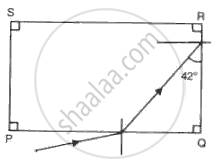Advertisements
Advertisements
प्रश्न
Answer the following question.
Describe the construction and working of an optical fibre.
उत्तर
Construction:
- An optical fibre consists of an extremely thin, transparent, and flexible core surrounded by an optically rarer flexible cover called cladding.
- For protection, the whole system is coated by a buffer and a jacket
- The entire thickness of the fibre is less than half an mm.
- Many such fibres can be packed together in an outer cover.

Construction of Optical fiber
Working:
- Working of optical fibre is based on the principle of total internal reflection.
- An optical signal (a ray of light) entering the core suffers multiple total internal reflections before emerging out after several kilometres.
- The optical signal travels with the highest possible speed in the material.
- The emerged optical signal has an extremely low loss in signal strength.

Working of Optical fibre
APPEARS IN
संबंधित प्रश्न
A ray of light travels from water to air as shown in the diagram given below :

1) Copy the diagram and complete the path of the way. Given the critical angle for water is 48°.
2) State the condition so that internal reflection occurs in the above diagram.
The diagram below shows a point source P inside a water container. Four rays A, B, C, D starting from the source P are shown up to the water surface

1) Show in the diagram the path of these rays after striking the water surface.
The Critical Angle for the water-air surface is 48°.
2) Name the phenomenon which the rays B and D exhibit.
Name the factors affecting the critical angle for the pair of media.
State the relation between the critical angle and the absolute refractive index of a medium.
Draw diagram to illustrate the total internal reflection.
One day Chetan’s mother developed a severe stomach ache all of a sudden. She was rushed to the doctor who suggested for an immediate endoscopy test and gave an estimate of expenditure for the same. Chetan immediately contacted his class teacher and shared the information with her. The class teacher arranged for the money and rushed to the hospital. On realizing that Chetan belonged to a below average income group family, even the doctor offered concession for the test fee. The test was conducted successfully.
Answer the following questions based on the above information:
(a) Which principle in optics is made use of in endoscopy?
(b) Briefly explain the values reflected in the action taken by the teacher.
(c) In what way do you appreciate the response of the doctor on the given situation?
The observation made by Swarali while doing the experiment is given below. Based on these write answers to the questions:
Swarali found that the light ray travelling from the denser medium to rarer medium goes away from the normal. If the angle of incidence (i) is raised by Swarali, the angle of refraction (r) went on increasing. However, after certain value of the angle of incidence the light ray is seen to return back into the denser medium.
Questions:
- What is the specific value of∠i called?
- What is the process of reflection of incident rays into denser medium called?
- Draw the diagrams of three observations made by Swarali.
Plot a graph between
Angle of incidence versus angle of reflection,
(a) A ray of monochromatic light enters glass PQRS as shown in the fig. Complete the path of ray till it emerges from the glass. (Critical angle of glass is 420).

(b) Draw diagram of a prism periscope.
(c) What are the advantages of total internal reflecting prism over plane mirror?
Can light be ‘piped’ like sound in a doctor’s stethoscope?
A ray of light incident at an angle of incidence ‘i’ passes through an equilateral glass prism such that the refracted ray inside the prism is parallel to its base and emerges from the prism at an angle of emergence ‘e’.
What can you say about the value of the angle of deviation in such a situation?
Name the factors affecting the critical angle for the pair of media.
What is meant by the statement, ‘the critical angle for diamond is 24°’?
A spherical marble, of refractive index 1.5 and curvature 1.5 cm, contains a tiny air bubble at its centre. Where will it appear when seen from outside?
Choose the correct option.
Select the WRONG statement.
Which of the following is not involved in formation of a rainbow?
Answer the following question.
Explain ‘mirage’ as an illustration of refraction.
Solve Numerical example.
From the given data set, determine angular dispersion by the prism and dispersive power of its material for extreme colours. nR = 1.62 nV = 1.66, δR = 3.1°
The resultant `vec"R"` of `vec"P"` and `vec"Q"` is perpendicular to `vec"P"`. Also `|vec"P"|=|vec"R"|`. The angle between `vec"P"` and `vec"Q"` is ______.
[tan 45° = 1]
For the same angle of incidence, the angle of refraction in four media A, B, C and D are 25°, 30°, 35° and 40° respectively. The speed of light is least in medium ______.
Which one of the following is NOT the correct formula for refractive index of glass w.r.t. air (aμg) (i = angle of incidence, r = angle of refraction)
The outer concentric shell in optic fiber is called ______.
The critical angle is defined as the angle of incidence at which the total internal reflection starts to occur.
The angle of incidence at which the angle of refraction is Q£ is called the critical angle.
The phenomena involved in the reflection of radiowaves by ionosphere is similar to ______.
A ray of light passes from vacuum into a medium of refractive index µ, the angle of incidence is found to be twice the angle of refraction. Then the angle of incidence is ______.
The angle made by incident ray of light with normal of the reflecting surface is called ______.
Find the value of θ in the given figure.

